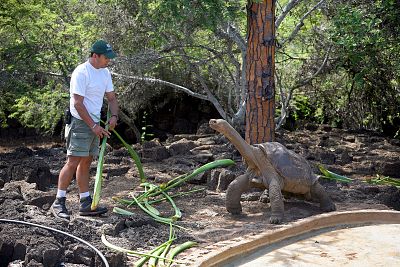Conservationists working on Ecuador's Galápagos Islands have discovered a young female tortoise that is partially related to Lonesome George.
Famed Galápagos tortoise Lonesome George's subspecies might not be extinct after all — researchers are calling the discovery of a surviving female relative "a story of hope" that the giant creature's legacy lives on.
When Lonesome George, the last known specimen of his kind who was estimated to be more than 100 years old, died in 2012, it marked the extinction of his Chelonoidis abingdonii subspecies.
But now, conservationists working on Ecuador's Galápagos Islands have discovered a young female tortoise that is partially related toLonesome George.
Researchers at the Galapagos Conservancy Inc., a nonprofit organization headquartered in Fairfax, Virginia, announced that the female tortoise is a direct descendant of the same species from Pinta Island as Lonesome George. The female specimen was found during a recent 10-day expedition to Wolf Volcano, a 5,600 foot tall peak on Isabela Island.
"We are absolutely thrilled that she was found," Johannah Barry, president of the Galapagos Conservancy, said. "This is very good news."
Lonesome George died of natural causes in June 2012. Despite numerous breeding attempts, the tortoise had been unable to reproduce. The new discovery suggests that his subspecies may not be extinct, and that hybrid tortoises with significant Pinta Island lineage could be living elsewhere in the Galápagos, offering conservation scientists hope amid what can often be the bleak work of tracking disappearing species.
The conservationists also retrieved 11 male tortoises and 18 other female tortoises from Wolf Volcano. These were found to be partially related to the Chelonoidis niger species from Floreana Island that was also considered extinct.
The discoveries could be enough to rewrite the extinction status of the Floreana species, according to Barry.
"I think we are cautiously optimistic that this is a species that we will be able to bring back from extinction and we can repopulate Floreana with tortoises that have significant Floreana lineage," she said.
It's too soon to know if the same can be said about the Pinta Island species, but Barry added that the existence of the female tortoise suggests other Pinta Island descendants could inhabit the region around Wolf Volcano.
The expedition was part of the Giant Tortoise Restoration Initiative, a joint venture between the Galapagos Conservancy and the Galapagos National Park Directorate. The 30 tortoises collected during the recent excursion have been transferred to a breeding center on Santa Cruz Island, where scientists will evaluate whether they will join captive breeding programs.
It's thought that seafarers, including whalers and pirates, transported tortoises among different islands, contributing to the hybrid species found on Wolf Volcano and elsewhere within the island chain. The conservancy estimates that the Galápagos Islands arehome to up to 15 separate tortoise species.
With the Wolf Volcano discovery, a small part of Lonesome George's legacy can live on, said Barry, who was present at the Santa Cruz Island center when the famed tortoise died.
"Anybody who was captivated by the Lonesome George story is going to be equally captivated by the story of a surviving relative," she said. "But it's also a story of hope. We may actually be able to repair some of the damage that we did, and that would be wonderful."












